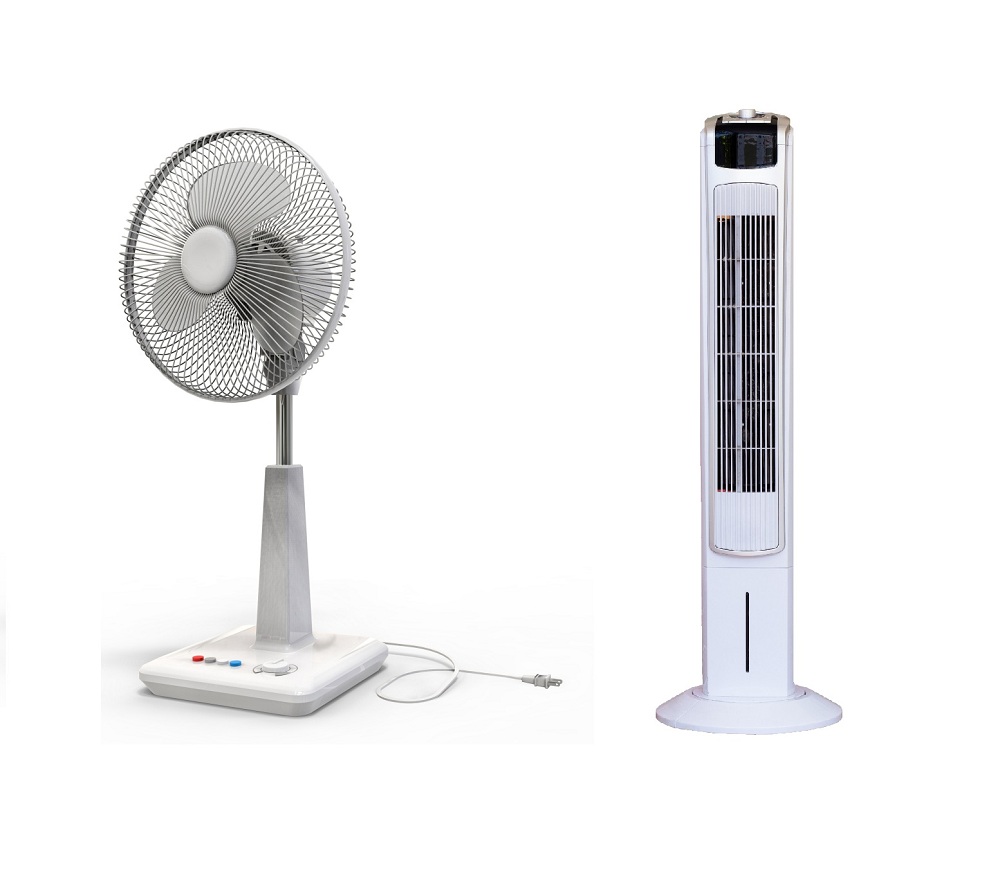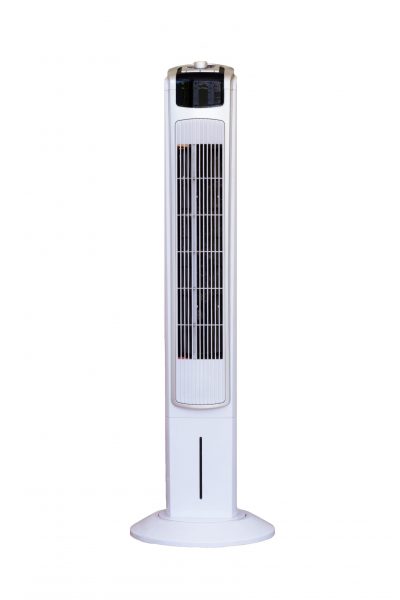Every year is the same – the summers are unbearably hot thanks to the relentless sunshine pouring through every window. No side of the house is safe as the fiery light moves across the sky as the day drags on.

Contrary to popular belief, not everyone likes the heat of summer. We need fans, and we need them now.
But which type of fan is the best one to choose for your home? There are so many fans out there, but today we’re only going to be focusing on the pedestal fan versus the tower fan types.
You might be wondering why does it matter, and we’ll be aiming to answer this question down below.
Pedestal and tower fans are similar in height and shape, but there are a couple of distinct differences. Both of these fans are better suited for different situations, so one type is not necessarily the best option for every situation.
Factors to Consider
Power
The power of a fan is one of the most important features to consider when choosing the right type of fan to go for.
Pedestal fans are often the most powerful rather than tower fans. A pedestal fan uses a propeller to blow air outwards in a wide range of directions, whereas a tower fan has a much smaller fan within a skinny structure.
Pedestal fans are often known for their power and that is why they’re used in large commercial spaces such as waiting rooms and garages.
There is no disputing that a pedestal fan offers a great airflow pressure that is certain to cool a room right down.
On the other hand; however, tower fans use smaller blades that spin around very quickly to throw out the air in any which direction.
This does not affect the power; however, so the airflow is not as impressive as that of a pedestal fan. Having said that, sometimes power is not all it’s made out to be.
For example, if you have a smaller space that you need cooling down a pedestal fan might produce too much air and make it uncomfortably cold rather than relaxing.
Not only will this be counterproductive to your plan, but it might also cost you more in energy bills. For this reason, tower fans are often considered better for smaller rooms despite not being as impressively powerful.
Winner: Pedestal Fans
Noise Level
The majority of high-quality fans on the market today are usually quiet and don’t produce a lot of noise pollution. However, tower fans generate cold air by turning their blades very quickly by using a motor.
This method, while effective, is often louder than pedestal fans because the larger motor and quicker mechanisms will generate more noise pollution.
Think of it as a wind turbine against the propeller of an airplane. Both are going to generate noise thanks to the continuous movement, but the turbine is going to be much louder. Although the tower fan offers less impressive power, it will also throw out more noise as well.
Pedestal fans are much quieter and you can often only hear the sound of the impressive airflow.
Winner: Pedestal Fans
Appearance
The appearance of both the pedestal and the tower fan varies slightly, with the main difference being the bulbous caged blades on the former.
A pedestal fan often comes with a long, thin pole holding up the three thick blades within a circular metal housing. We’ll admit it, they’re not the most attractive of fans.
Alternatively, tower fans are one width all the way up and are often either white or black. They can be stood in corners without any hassle or tight spaces, and they’ll commonly be able to blend into their surroundings. For this reason, tower fans are less of an eyesore than pedestal fans.
Fans only generate air from the blades, which are only found right at the top of pedestal models. This means that if you want a fan to cool the air below the fan, you might be left unsatisfied with your fan.
However, tower fans offer an airflow up the entire height of the fan. While tower fans don’t offer as much power as pedestal fans, they can offer a stream of cool air nearer to the floor. This can make them ideal for households with children or pets that also need the relief of a fan in hot weather.
Both the pedestal and the tower fan can be easily maneuvered and they aren’t heavy enough to stop you from moving them from room to room depending on where they’re needed.
Don’t worry, though, as they still should be sturdy enough to prevent children and pets from knocking them over.
Winner: Tower Fans
Space
Following on from the previous comparison, let’s talk about how much space your fan is going to take up.
Pedestal fans have a large base to keep the fan sturdy, meaning that this type of fan is going to take up more floor space than a tower fan. Tower fans can get away with a smaller base because they are not as top-heavy as the alternative.
So, tower fans can fit into smaller spaces thanks to the fact that they take up less floor space. Tower fans are also often shorter than pedestal fans, so they take up less overall space as well.
Of course, this affects the airflow that you receive, but if you don’t need the maximum cooling effect and are strapped for space, a tower fan might be ideal.
Having said this, pedestal fans offer cooling air at higher levels so that you can position it behind you and still feel the effects.
If you were to put a tower fan behind a chair, you might not feel anything at all as the fabric is blocking the airflow.
For this reason, you might find that a pedestal fan works for your individual situation better.
Another thing to note is that a pedestal fan offers a thin metal pole in between the large base and blades, which doesn’t take up much space at all. If you were to place the base underneath a couch or table, you could scoot the fan very close to the furniture to save space.
So, if you were thinking about getting a pedestal fan but don’t have much room to waste, all hope is not lost.
Winner: Tie
Features
The main features of fans that the majority of people enjoy are rotation, timers, modes, and remote controls so that you can operate the fan from anywhere in the room.
It’s more common to find these features associated with tower fans, but some high-quality pedestal fans are beginning to come with impressive add-ons like these.
Having said that, you can still get plenty of basic pedestal fans without any additional features at all. If you were to opt for the least expensive tower fan and pedestal fan and compared them, it’s highly likely that the former will have more features up for grabs than the latter.
So, if you don’t have the budget for a high-quality fan with all the bells and whistles but still want a fan that boasts a few impressive features, we would recommend you going with a tower fan.
Winner: Tower Fans
Summary
So, what’s the verdict? Should you spend your money on a pedestal fan or a tower fan? Well, your decision will have to be down to your personal preference and needs.
A pedestal fan offers more power and therefore will cool larger spaces, and they’re also quieter than tower fans.
However, tower fans can come in a range of cool designs and they don’t look as out of place in your house as a pedestal fan might. Moreover, tower fans take up less space and they often come with more features than pedestal fans.
Overall, both the pedestal and the tower fan are both respectable models that are certain to cool you down when the relentless summer brings the sweaty weather.
Related Posts
- How to Stop Sliding Doors from Rattling – Causes and Solutions
- Cheap Ways to Heat a Room – Efficient and Budget-Friendly Solutions
- 11 Ways to Get Rid of Cooking Smells in a Small Apartment or House
- 11 Stores and Sites Like IKEA For Affordable Furniture and Home Products
- All About Polypropylene – Olefin Fabric Sofa Material
- 12 Different Types of Wood for Outdoor Furniture with Pros/Cons


Leave a Reply